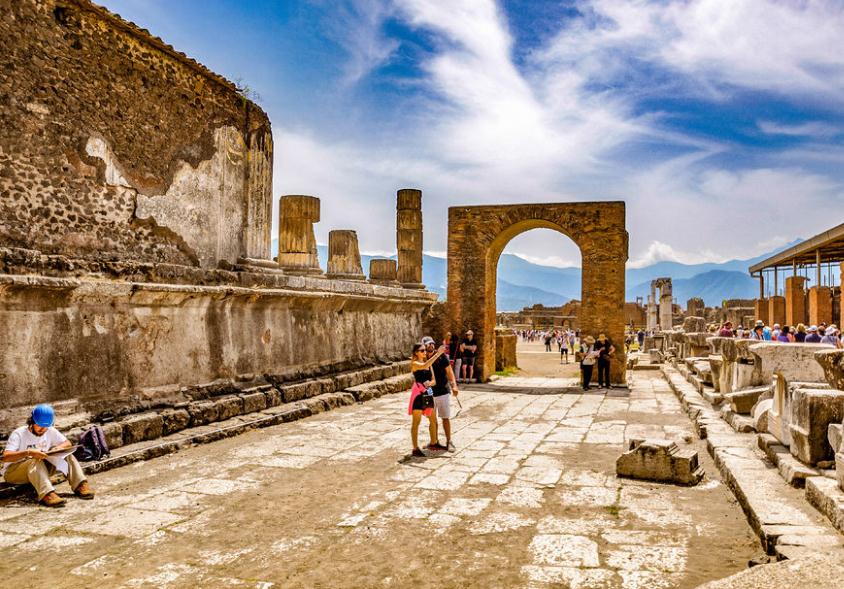The Ultimate Italian Grand Tour: From Rome to the Amalfi Coast
This comprehensive travel guide outlines a classic Italian itinerary, weaving through the country's most iconic cities, enchanting hill towns, and breathtaking coastal landscapes. The journey is a deep dive into the heart of Italian culture, history, art, and cuisine, offering practical advice for a seamless and enriching experience.
Part 1: Lazio & Tuscany - The Heart of History and Renaissance
Rome: The Eternal City
Rome, Italy's capital, is a sprawling, layered metropolis where ancient history and modern life vibrantly coexist. A minimum of three to four days is recommended to scratch the surface of its endless treasures.
Main Attractions: The Colosseum, Roman Forum, and Palatine Hill form the core of ancient Rome. The Vatican City, an independent state, houses St. Peter's Basilica and the Vatican Museums, home to Michelangelo's Sistine Chapel ceiling. The Pantheon, Trevi Fountain, and Spanish Steps are essential stops in the historic center.
Food & Drink: Indulge in classic Roman pasta dishes like Cacio e Pepe (cheese and pepper) and Carbonara. Enjoy a slice of thin, crispy pizza al taglio (pizza by the slice) and cool down with a scoop of authentic gelato. Don't forget to drink from the city's public water fountains, known as nasoni.
Transportation: Rome has a comprehensive public transport system including metro, buses, and trams. The historic center is best explored on foot. The Roma Pass can offer discounts and free public transport.
Accommodation Tip: Stay in central neighborhoods like Trastevere for a lively, authentic atmosphere, near the Termini Station for convenience, or in the historic center (Centro Storico) to be within walking distance of major sites.
Cultural Insight: Romans live life outdoors. Embrace the passeggiata, the traditional evening stroll, where locals of all ages walk through the city's piazzas and streets to see and be seen.
Civita di Bagnoregio: The Dying Town (Sky City)
Perched atop a crumbling tufa hill and accessible only by a long pedestrian bridge, Civita di Bagnoregio is a breathtakingly beautiful medieval village that seems frozen in time. It's often called "Il Paese che Muore" (The Dying Town) due to ongoing erosion.
Main Attractions: The main attraction is the town itself. Wander its silent, narrow alleys, admire the stone houses, and visit the Romanesque church of San Donato. The panoramic views of the surrounding "Valley of the Badlands" are spectacular.
Food & Drink: Due to its small size, options are limited but charming. Enjoy a simple lunch at a family-run trattoria. The region is known for its olive oil and wine.
Transportation: Civita is best visited as a day trip from Rome or Orvieto. Travel by train to Orvieto, then take a local bus to Bagnoregio, from where you walk across the bridge to Civita.
Cultural Insight: With only a handful of full-time residents, visiting Civita is a lesson in resilience and preservation. It offers a rare glimpse into a vanishing way of life and the powerful forces of nature.
Siena: The Gothic Masterpiece
A UNESCO World Heritage site, Siena is the embodiment of a medieval Tuscan city. Its red-brick buildings, shell-shaped main square, and passionate Palio horse race define its unique character.
Main Attractions: The Piazza del Campo is one of Europe's greatest medieval squares. The Siena Cathedral (Duomo) is a stunning mix of Romanesque and Gothic architecture with a magnificent marble floor and works by Donatello and Michelangelo. Climb the Torre del Mangia for an unforgettable view.
Food & Drink: Siena is famous for its rich, spicy panforte cake and chewy ricciarelli almond cookies. Enjoy pici pasta, a thick, hand-rolled local specialty, often served with wild boar sauce (cinghiale).
Transportation: Siena is well-connected by bus from Florence. The train station is located at the bottom of the hill, requiring a bus ride to the city center. The city itself is pedestrian-friendly.
Cultural Insight: Sienese identity is fiercely tied to their contrade (city districts). The Palio, a historic horse race held twice a year in the Piazza del Campo, is not a tourist event but a profound expression of local rivalry and pride.
Pisa: More Than Just a Tower
While globally famous for its Leaning Tower, Pisa offers a beautiful ensemble of religious architecture in the Piazza dei Miracoli (Field of Miracles).
Main Attractions: The Leaning Tower is the star, but the adjacent Cathedral (Duomo), Baptistery, and Camposanto Monumentale (monumental cemetery) are equally impressive. A climb up the tower provides a unique, sloping perspective.
Food & Drink: Try cecina, a savory chickpea flour pancake, often enjoyed stuffed in a focaccia bread. The area is also known for its hearty soups like ribollita.
Transportation: Pisa is easily reached by train from Florence, Lucca, or La Spezia (for the Cinque Terre). The Pisa Centrale station is about a 30-minute walk or a short bus ride from the Field of Miracles.
Cultural Insight: Pisa was a powerful maritime republic rivaling Genoa and Venice. The grandeur of the Piazza dei Miracoli is a direct testament to its historical wealth and importance during the Middle Ages.
Cinque Terre: The Five Lands
The Cinque Terre is a string of five centuries-old seaside villages clinging to the rugged Italian Riviera coastline. Colorful houses, vineyards, terraced hillsides, and a network of scenic trails define this UNESCO-protected national park.
Main Attractions: The five villages—Monterosso al Mare, Vernazza, Corniglia, Manarola, and Riomaggiore—each have their own charm. Hike the famous trails like the Sentiero Azzurro for breathtaking coastal views. Take a boat tour to see the villages from the sea.
Food & Drink: Feast on fresh anchovies (acciughe) prepared in various ways, and try trofie pasta with pesto, a Ligurian specialty. Enjoy a glass of Sciacchetrà, the local sweet wine.
Transportation: The Cinque Terre Express train efficiently connects all five villages and La Spezia. A Cinque Terre Trekking Card or combined train-and-hiking card is highly recommended. Boats are also available seasonally.
Accommodation Tip: Accommodation is limited and books up quickly. Consider staying in La Spezia for more options and easy train access. If staying in a village, be prepared for stairs and hills.
Cultural Insight: The Cinque Terre landscape is a monument to human perseverance. For generations, locals have built and maintained thousands of kilometers of dry-stone walls to create terraces for vineyards and olive groves on the steep cliffs.
Tuscan/Italian Hill Town (e.g., San Gimignano or Montepulciano)
A trip to Tuscany is incomplete without exploring one of its iconic hilltop towns, which offer quintessential views of cypress-lined roads and rolling hills.
Suggestion - San Gimignano: Known as the "Medieval Manhattan" for its famous medieval towers. Wander through its well-preserved historic center, visit the Collegiata church with its frescoes, and enjoy world-renowned gelato from Gelateria Dondoli.
Suggestion - Montepulciano: Famous for its robust Vino Nobile wine. Explore the elegant Renaissance palaces, walk along the main street lined with wine cellars (cantine), and enjoy panoramic views of the Val d'Orcia.
Milan: The Fashion Capital
Milan is Italy's dynamic financial and fashion hub, offering a stark contrast to the historical centers of Rome and Florence with its modern energy and world-class culture.
Main Attractions: Leonardo da Vinci's "The Last Supper" (requires booking months in advance), the magnificent Duomo di Milano (cathedral) with its rooftop walk, the Galleria Vittorio Emanuele II shopping arcade, and the La Scala opera house.
Food & Drink: Milan is known for risotto alla Milanese (saffron risotto) and cotoletta alla Milanese (a breaded veal cutlet). Enjoy an aperitivo—a pre-dinner drink accompanied by a buffet of snacks—in the Navigli district's canalside bars.
Transportation: Milan has an extensive metro system that is efficient and easy to use. Malpensa (MXP) and Linate (LIN) are the main airports. Milan is also Italy's primary high-speed rail hub.
Cultural Insight: Milanese culture is fast-paced and design-conscious. The aperitivo ritual is a key social event, reflecting a sophisticated urban lifestyle focused on business, fashion, and socializing.
Lake Garda: Italy's Largest Lake
Situated between Milan and Venice, Lake Garda offers a dramatic landscape with alpine scenery in the north and Mediterranean vibes in the south. It's a popular destination for relaxation and outdoor activities.
Main Attractions: Visit Sirmione for its Scaligero Castle and Grottoes of Catullus ruins. Riva del Garda in the north offers windsurfing and hiking. Malcesine features a charming old town and a cable car up Monte Baldo for stunning views.
Food & Drink: Lake fish like trout, perch, and sardines are staples. Try bigoli pasta with sardines or risotto with perch. The region also produces excellent olive oil.
Transportation: Buses run along most of the lake's perimeter. Ferries and hydrofoils are the most scenic and pleasant way to travel between lakeside towns.
Cultural Insight: Lake Garda has been a cherished retreat since Roman times. Its towns showcase a blend of Italian, Austrian, and Venetian influences, reflecting its strategic location at the crossroads of different cultures.
Venice: The Floating City
Venice is a magical city built on over 100 small islands in a lagoon. Its canals, gondolas, Gothic architecture, and atmospheric alleyways create an utterly unique and romantic environment.
Main Attractions: St. Mark's Square (Piazza San Marco) with St. Mark's Basilica and the Campanile, the Doge's Palace, and the Rialto Bridge. Take a gondola ride on the smaller canals and a vaporetto (water bus) along the Grand Canal.
Food & Drink: Sample cicchetti (Venetian tapas) in a traditional bacaro (wine bar). Enjoy seafood risotto, fegato alla veneziana (liver with onions), and polenta. Spritz, made with Prosecco and Aperol or Campari, is the classic Venetian drink.
Transportation: Walking and vaporetti are the primary modes of transport. Cars are not allowed in the historic center. The Venice Connected card can be useful for public transport and museum entry.
Accommodation Tip: Staying on the main island (like San Marco or Cannaregio) offers the most atmospheric experience but can be expensive. Mestre on the mainland offers more affordable options with easy train/bus access.
Cultural Insight: Venice's history as a sovereign republic for over a millennium has given it a culture distinct from the rest of Italy. Its survival against the tides (acqua alta) is a daily reality and a testament to its enduring spirit.
Florence: The Cradle of the Renaissance
The capital of Tuscany is an open-air museum packed with some of the world's most renowned art and architecture from the Renaissance period.
Main Attractions: The Duomo (Cathedral of Santa Maria del Fiore) with Brunelleschi's Dome, the Uffizi Gallery (Botticelli's "Birth of Venus"), the Accademia Gallery (Michelangelo's "David"), and the Ponte Vecchio bridge lined with jewelry shops.
Food & Drink: Florence is famous for its bistecca alla fiorentina (T-bone steak), ribollita soup, and lampredotto (tripe sandwich). Chianti wine from the surrounding hills is a must-try.
Transportation:The historic center is very walkable. Florence is a major stop on Italy's high-speed rail network, making it easily accessible from Rome, Milan, and Venice.
Cultural Insight: | 景点门票
那不勒斯+庞贝一日游(罗马出发)
From Rome: Full-Day Pompeii and its Ruins
卡利亚里1.5小时徒步游(2人起卖)
Cagliari: 1.5 Hour Walking Tour



